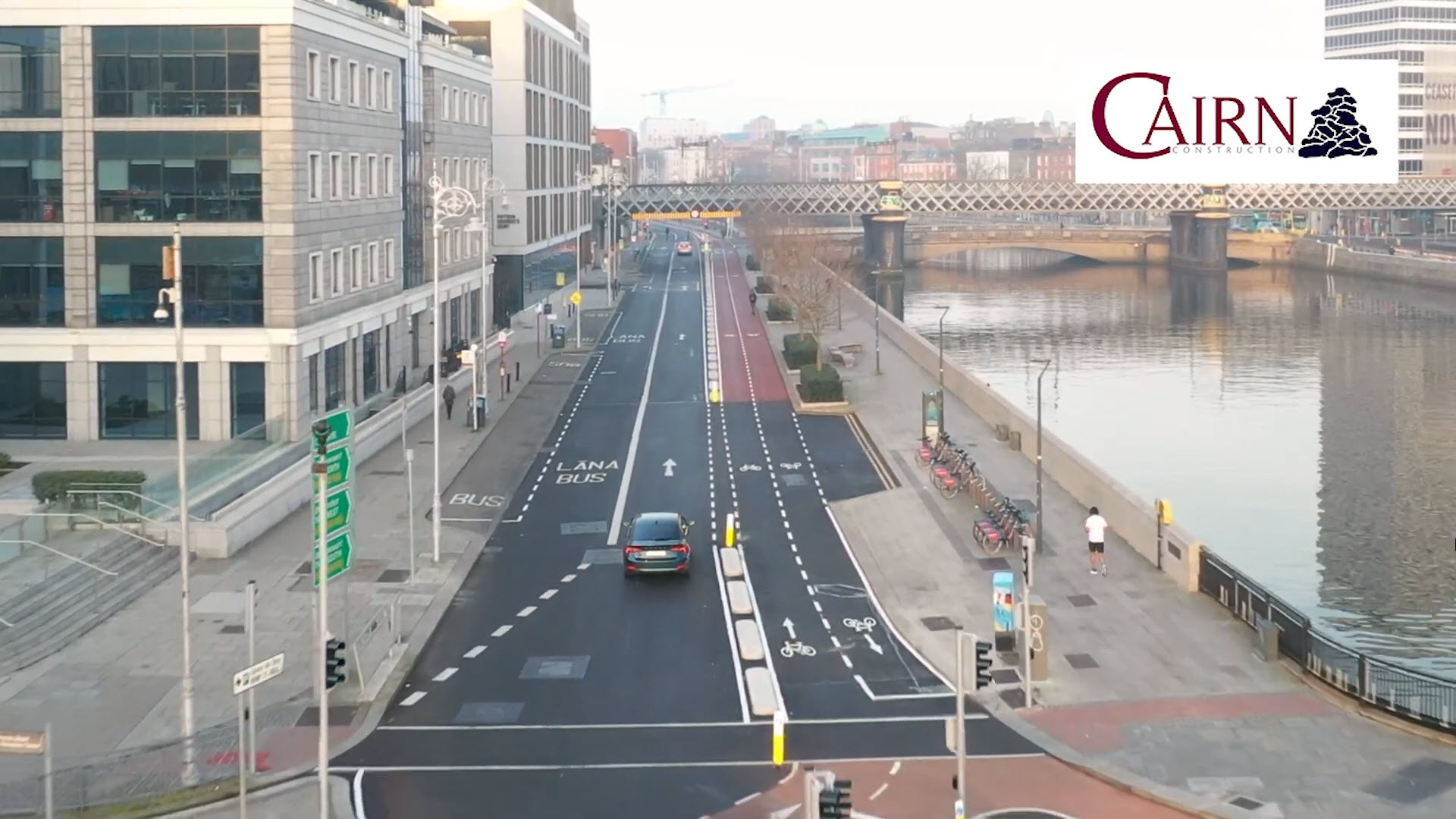
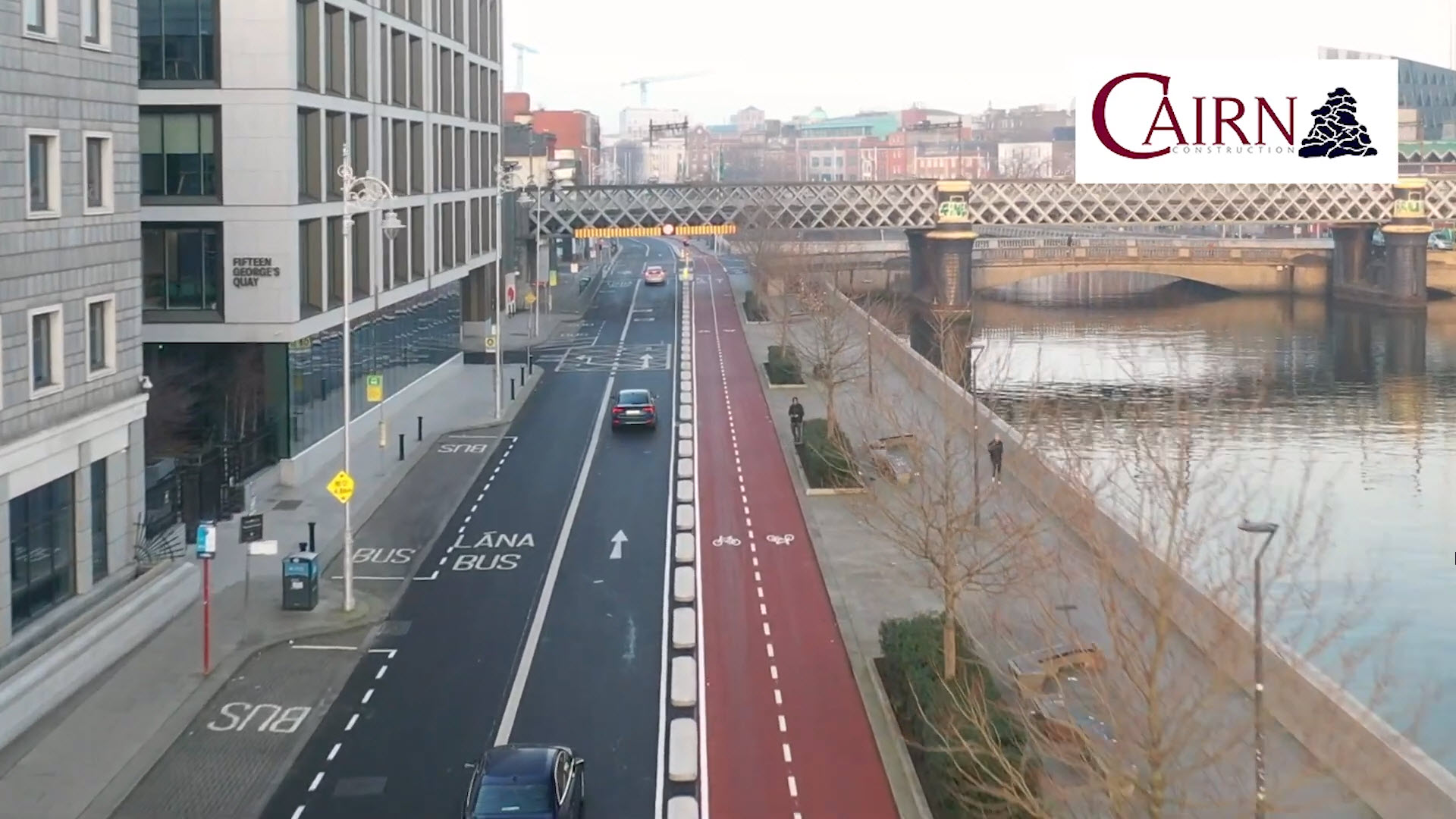
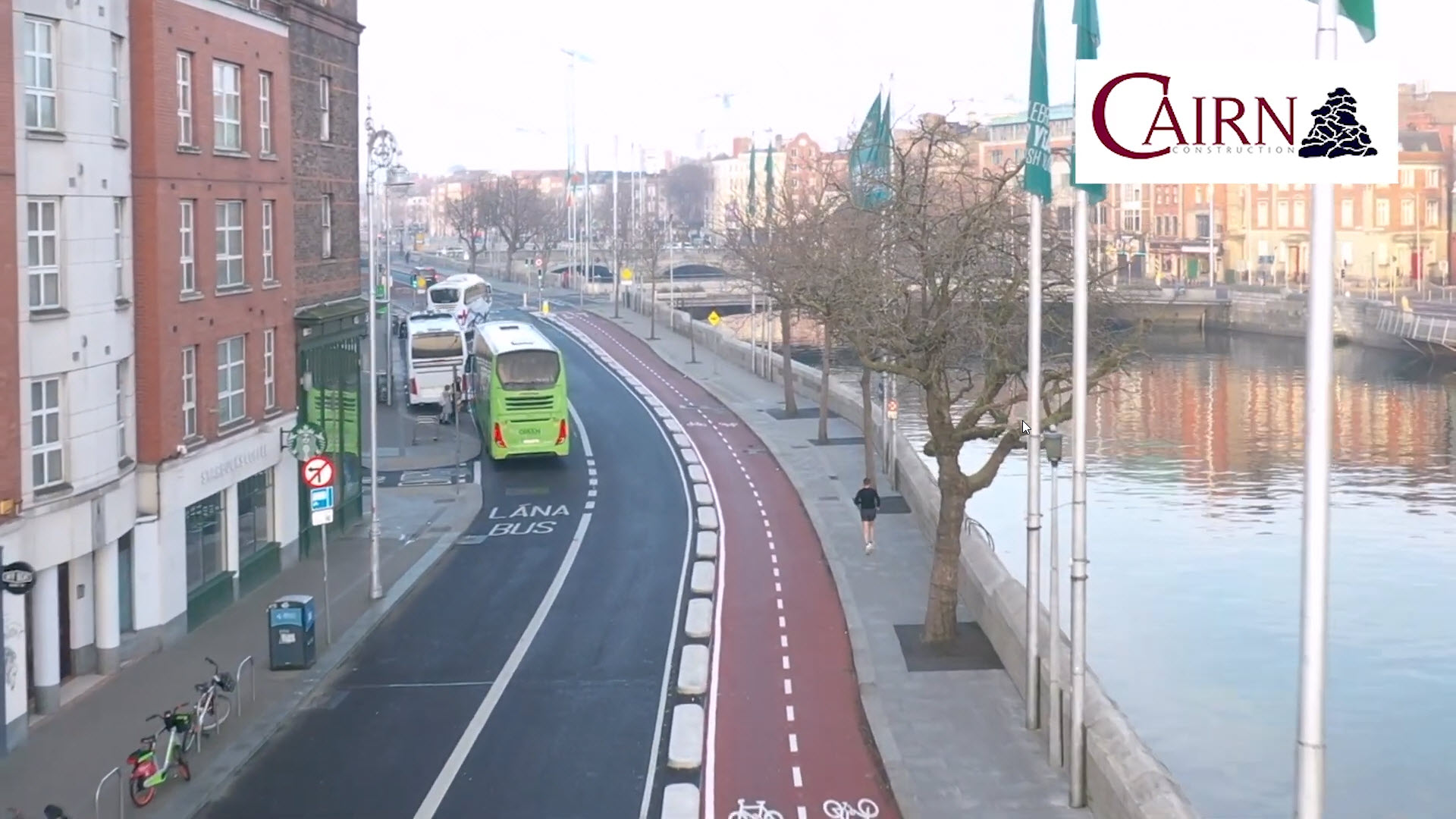
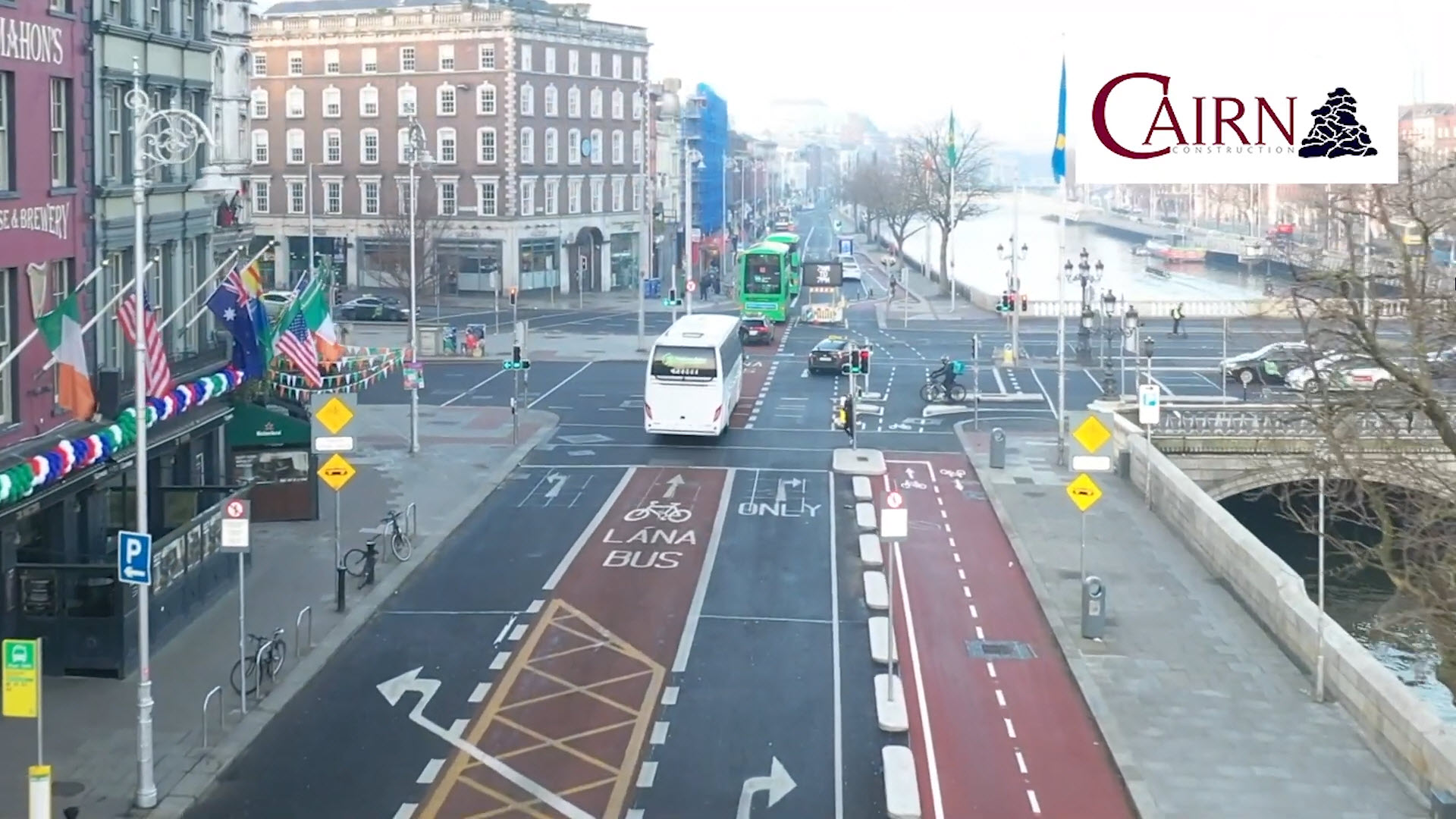
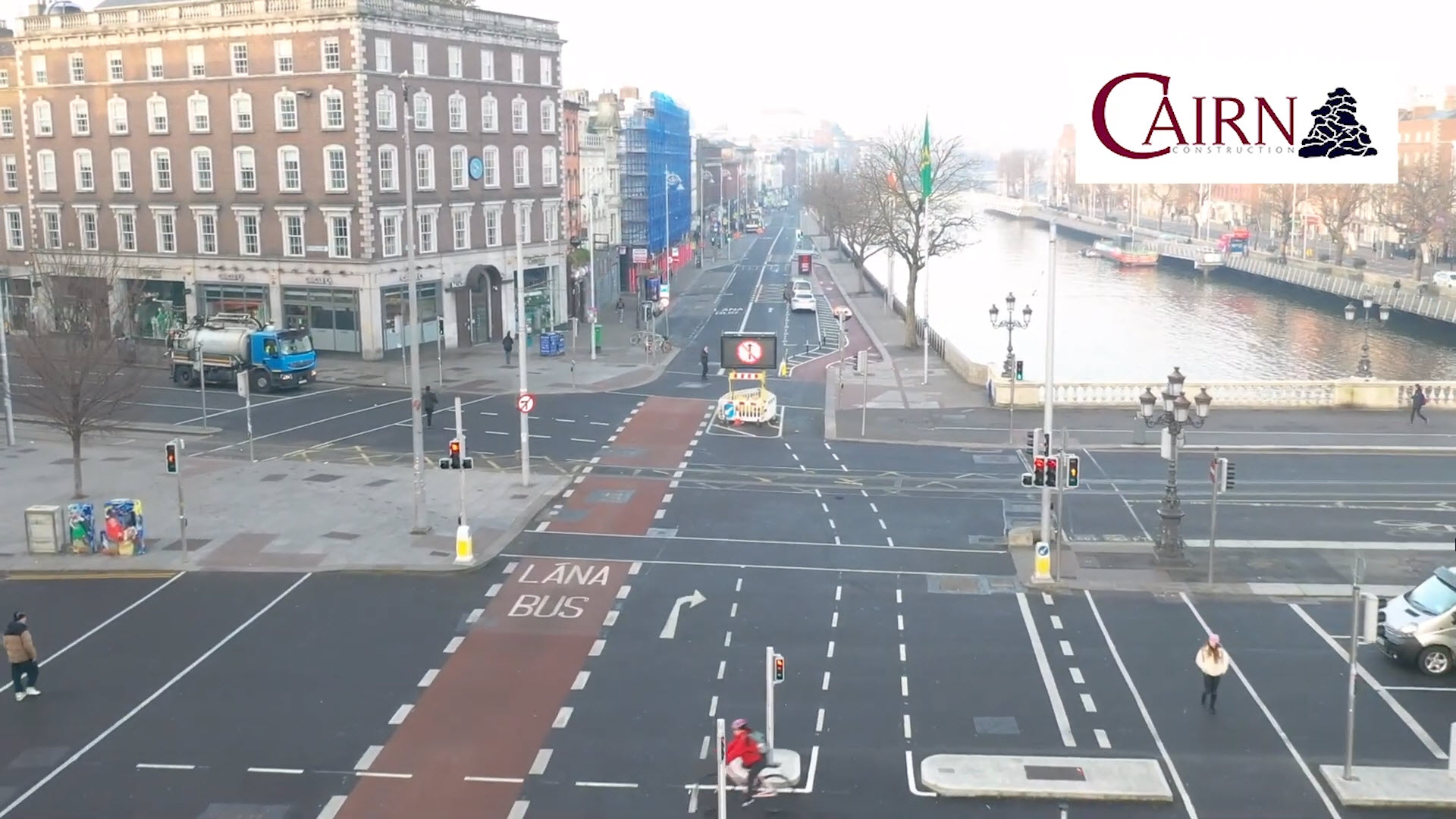







Active Travel - New Dedicated Two Way Cycle Track - South Quays, Dublin City Centre.
As part of its commitment to the active travel initiative, greening and the creation of a cyclist friendly city environment Dublin City Council decided to build a dedicated 1.5km long cycle lane from the Matt Talbot Bridge to the Ha’penny Bridge. This work called upon the meticulous planning and management of; 75,000 daily pedestrians, 6,500 cyclists, 30,000 motorists, two Luas lines, emergency services, utility providers, local businesses, Irish Rail, Dublin Bus, private bus operators.
Due to the delicate and intricate nature of the proposed scheme, the works were planned and executed over seven separate phases. All work phases were supported by comprehensive traffic and pedestrian management plans, risk assessments and method statements, waste and environmental management plans, communications plans, works programme and a project management plan. Once approval was obtained for a phase, we erected all approved traffic and pedestrian management initiatives. To prove the effectiveness and safety of the arrangement we tested it for operability and effectiveness for 3 days before commencing works. The arrangement was checked by our full time site based SLG qualified and experienced TM Supervisor Haxi Ferati. We also allocated a full time Liaison Officer and Services Coordinator to the project.
Over the 1.5km length of the scheme we traversed recognizable Dublin Infrastructure including; The Matt Talbot Bridge, Butt Bridge, Rosie Hackett Bridge, O'Connell Bridge and the Ha'penny Bridge. Both the O'Connell Bridge and the Rosie Hackett Bridge support the Live Luas Lines. In order to accommodate the new two way cycle lane the existing carriageway was reduced from three to two lanes.
Key site activities included; 1,500m of 4 way ducting including 30 new chambers, scarifying and recycling 9,000m2 of existing carriageway, renewing 50 number manhole chamber and gully covers, realigning 1,000m of antique granite kerbs, installing 500m of new silver granite kerbs, protecting 20 number existing trees, 150m2 of new tactile paving, installing and connecting 25 number new gullies, repositioning 25 number existing gullies including new connections, 200 number cast in-situ cyclist separating safety bollards, 50 number new bicycle stands and 6 number new controlled pedestrian crossings.
All of the works impacted on the live Luas line, all utility bodies, emergency services, bus operators, local businesses. Hence permanent communications was established and maintained with all of them. Our full time site based Liaison Officer Cathal Fanning met with all of them at Contract Award stage. At the initial meeting we agreed that all works impacting on the Luas line would be carried out at Night Time. The new 1.5km 4 way ducting impacted on the existing ESB high voltage line. To that end, whenever works were planned adjacent to the ESB cable we provided them with 6 weeks advance notice so that their supervisor was present. Before any works commenced in a phase, we completed a thorough GPR survey of the area.
During the works we employed hand excavation techniques around sensitive areas always maintaining a CAT in the vicinity.
Nuisance management was achieved by using modern day fully serviced silenced mini plant, wetting down during saw cutting and dry spells, working in small areas and exporting excavated materials in out of hours.
As part of the works we altered four number traffic and pedestrian management controlled signals. That entailed the creation of temporary controls during the works and the installation of the permanent signals at phase completion stage. Finishing works included 2,500m2 of red coloured anti-slip asphalt, 500m2 of red epoxy asphalt, cycle lane markings, new road and cycle lane signage. The existing 9,000m2 carriageway was all scarified and re-laid in two layers in out of hours work over 15 separate phases. Once laid and cred we then provided all specified safety road markings and signage.
The project was finished 3 months ahead of programme and within budget without any negative impact on existing services to the full satisfaction of all project stakeholders.
During the works we encountered numerous challenges and all of them were catered for and effectively managed using the following strategies.
| CHALLENGE | IMPLEMENTED SOLUTION |
|---|---|
| Effective communications with affected stakeholders. |
Appointment of a full time Liaison Officer. Timely letter drop to all stakeholders. Ongoing communications with fortnightly newsletter emailed. The initial letter drop contained contact details for our Project Manager, Site Foreman and Liaison Officer. The TM arrangement was all tested for safety and effectiveness before implementation. |
| Nuisance Management - Noise, Dust, Vibrations and Litter | New and fully serviced mini plant. Wetting down during dry spells and saw cutting, noise. Litter barriers. Site and activity inductions. Daily integrated HSEQ audits. Daily Tool Box Talks. |
| Delivering a high quality project | At Contract Award stage, we designed and implemented a rigorous QA Plan. Throughout the works daily HSEQ audits were undertaken with all non-conformances closed out in a timely manner. All works were inspected and tested as the works progressed. |
| Identifying, protecting and upgrading utility services | We allocated a full time services coordinator to the project. Timely contact with all utility providers. Initial CCTV and GPR surveys. Hand excavation in more sensitive areas. All excavators accompanied by a banksman. |
| Ensuring site safety | Site inductions, Activity Inductions, Daily Tool Box Talks, Risk Assessments and Method Statements. Daily HSEQ audits. |
| Site Security | All works areas clearly separated and segregated from the general public. Clear visible signage in all cases. |
All existing hard surfaces including existing kerbs/paving were all carefully excavated and exported to licensed recycling facilities. The project was planned and supported by a Communications Plan, Works Programme, H&S Plan, QA Plan and a Waste & Environmental Management Plan. Both progress and safety on the project was also monitored in real time by the use of CCTV cameras.
Copyright Cairn Construction. Design by HTML Codex